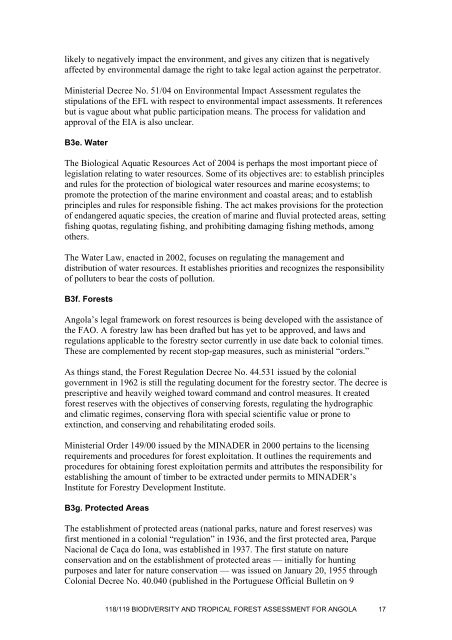118/119 Biodiversity and Tropical Forest Assessment for Angola
118/119 Biodiversity and Tropical Forest Assessment for Angola
118/119 Biodiversity and Tropical Forest Assessment for Angola
- No tags were found...
You also want an ePaper? Increase the reach of your titles
YUMPU automatically turns print PDFs into web optimized ePapers that Google loves.
likely to negatively impact the environment, <strong>and</strong> gives any citizen that is negativelyaffected by environmental damage the right to take legal action against the perpetrator.Ministerial Decree No. 51/04 on Environmental Impact <strong>Assessment</strong> regulates thestipulations of the EFL with respect to environmental impact assessments. It referencesbut is vague about what public participation means. The process <strong>for</strong> validation <strong>and</strong>approval of the EIA is also unclear.B3e. WaterThe Biological Aquatic Resources Act of 2004 is perhaps the most important piece oflegislation relating to water resources. Some of its objectives are: to establish principles<strong>and</strong> rules <strong>for</strong> the protection of biological water resources <strong>and</strong> marine ecosystems; topromote the protection of the marine environment <strong>and</strong> coastal areas; <strong>and</strong> to establishprinciples <strong>and</strong> rules <strong>for</strong> responsible fishing. The act makes provisions <strong>for</strong> the protectionof endangered aquatic species, the creation of marine <strong>and</strong> fluvial protected areas, settingfishing quotas, regulating fishing, <strong>and</strong> prohibiting damaging fishing methods, amongothers.The Water Law, enacted in 2002, focuses on regulating the management <strong>and</strong>distribution of water resources. It establishes priorities <strong>and</strong> recognizes the responsibilityof polluters to bear the costs of pollution.B3f. <strong>Forest</strong>s<strong>Angola</strong>’s legal framework on <strong>for</strong>est resources is being developed with the assistance ofthe FAO. A <strong>for</strong>estry law has been drafted but has yet to be approved, <strong>and</strong> laws <strong>and</strong>regulations applicable to the <strong>for</strong>estry sector currently in use date back to colonial times.These are complemented by recent stop-gap measures, such as ministerial “orders.”As things st<strong>and</strong>, the <strong>Forest</strong> Regulation Decree No. 44.531 issued by the colonialgovernment in 1962 is still the regulating document <strong>for</strong> the <strong>for</strong>estry sector. The decree isprescriptive <strong>and</strong> heavily weighed toward comm<strong>and</strong> <strong>and</strong> control measures. It created<strong>for</strong>est reserves with the objectives of conserving <strong>for</strong>ests, regulating the hydrographic<strong>and</strong> climatic regimes, conserving flora with special scientific value or prone toextinction, <strong>and</strong> conserving <strong>and</strong> rehabilitating eroded soils.Ministerial Order 149/00 issued by the MINADER in 2000 pertains to the licensingrequirements <strong>and</strong> procedures <strong>for</strong> <strong>for</strong>est exploitation. It outlines the requirements <strong>and</strong>procedures <strong>for</strong> obtaining <strong>for</strong>est exploitation permits <strong>and</strong> attributes the responsibility <strong>for</strong>establishing the amount of timber to be extracted under permits to MINADER’sInstitute <strong>for</strong> <strong>Forest</strong>ry Development Institute.B3g. Protected AreasThe establishment of protected areas (national parks, nature <strong>and</strong> <strong>for</strong>est reserves) wasfirst mentioned in a colonial “regulation” in 1936, <strong>and</strong> the first protected area, ParqueNacional de Caça do Iona, was established in 1937. The first statute on natureconservation <strong>and</strong> on the establishment of protected areas — initially <strong>for</strong> huntingpurposes <strong>and</strong> later <strong>for</strong> nature conservation — was issued on January 20, 1955 throughColonial Decree No. 40.040 (published in the Portuguese Official Bulletin on 9<strong>118</strong>/<strong>119</strong> BIODIVERSITY AND TROPICAL FOREST ASSESSMENT FOR ANGOLA 17
















